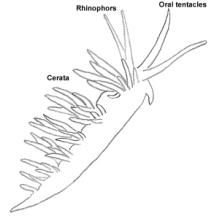 Opisthobranch Overview
Opisthobranch Overview
 What Is An Opisthobranch
An opisthobranch is marine gastropod characterized by two pairs of oral tentacles, horn-like olfactory organs called
rhinophores, and significantly reduced or absent shell and no operculum. They are hermaphroditic and most have
highly specialized diets. Most are benthic and occur in the intertidal and subtidal zones. Individuals within
Opisthobranchia are commonly called sea slugs, sea hares, bubble shells, dorids, sea angels, and sea butterflies.
Currently, the phylogeny within Opisthobrancia is under review;
however, one system breaks the subclass into seven orders.
Opisthobranchs utilize several methods of defense, including camouflage,
warning coloration, behavioral strategies, and chemical defense.
Some nudibranchs even incorporate nematocysts from from their prey
into their bodies. Although not necessarily a defensive mechanism,
they are known to regenerate missing body parts as well.
The anatomy of opisthobranchs varies among the diferent orders and
species. Nudibranchs most commonly occur in to variations of two basic
forms. Below are two schematics characterizing the two most commonly
regarded nudibranch forms. Cerata are dorsal projections which may house the digestive organ, act as a respiratory
organ, and contain stolen nematocysts. Rhinophores are sensory organs used in navigation and feeding. Tubercles
are small bumps on the dorsal surface. A branchial plume is a respiratory organ.
For more information about nudibranchs or other opisthobranchs, please visit the references and links page for a
list of books and web sites containing pertinent information. .
What Is An Opisthobranch
An opisthobranch is marine gastropod characterized by two pairs of oral tentacles, horn-like olfactory organs called
rhinophores, and significantly reduced or absent shell and no operculum. They are hermaphroditic and most have
highly specialized diets. Most are benthic and occur in the intertidal and subtidal zones. Individuals within
Opisthobranchia are commonly called sea slugs, sea hares, bubble shells, dorids, sea angels, and sea butterflies.
Currently, the phylogeny within Opisthobrancia is under review;
however, one system breaks the subclass into seven orders.
Opisthobranchs utilize several methods of defense, including camouflage,
warning coloration, behavioral strategies, and chemical defense.
Some nudibranchs even incorporate nematocysts from from their prey
into their bodies. Although not necessarily a defensive mechanism,
they are known to regenerate missing body parts as well.
The anatomy of opisthobranchs varies among the diferent orders and
species. Nudibranchs most commonly occur in to variations of two basic
forms. Below are two schematics characterizing the two most commonly
regarded nudibranch forms. Cerata are dorsal projections which may house the digestive organ, act as a respiratory
organ, and contain stolen nematocysts. Rhinophores are sensory organs used in navigation and feeding. Tubercles
are small bumps on the dorsal surface. A branchial plume is a respiratory organ.
For more information about nudibranchs or other opisthobranchs, please visit the references and links page for a
list of books and web sites containing pertinent information. .
 Opisthobranch Overview
Opisthobranch Overview
 What Is An Opisthobranch
An opisthobranch is marine gastropod characterized by two pairs of oral tentacles, horn-like olfactory organs called
rhinophores, and significantly reduced or absent shell and no operculum. They are hermaphroditic and most have
highly specialized diets. Most are benthic and occur in the intertidal and subtidal zones. Individuals within
Opisthobranchia are commonly called sea slugs, sea hares, bubble shells, dorids, sea angels, and sea butterflies.
Currently, the phylogeny within Opisthobrancia is under review;
however, one system breaks the subclass into seven orders.
Opisthobranchs utilize several methods of defense, including camouflage,
warning coloration, behavioral strategies, and chemical defense.
Some nudibranchs even incorporate nematocysts from from their prey
into their bodies. Although not necessarily a defensive mechanism,
they are known to regenerate missing body parts as well.
The anatomy of opisthobranchs varies among the diferent orders and
species. Nudibranchs most commonly occur in to variations of two basic
forms. Below are two schematics characterizing the two most commonly
regarded nudibranch forms. Cerata are dorsal projections which may house the digestive organ, act as a respiratory
organ, and contain stolen nematocysts. Rhinophores are sensory organs used in navigation and feeding. Tubercles
are small bumps on the dorsal surface. A branchial plume is a respiratory organ.
For more information about nudibranchs or other opisthobranchs, please visit the references and links page for a
list of books and web sites containing pertinent information. .
What Is An Opisthobranch
An opisthobranch is marine gastropod characterized by two pairs of oral tentacles, horn-like olfactory organs called
rhinophores, and significantly reduced or absent shell and no operculum. They are hermaphroditic and most have
highly specialized diets. Most are benthic and occur in the intertidal and subtidal zones. Individuals within
Opisthobranchia are commonly called sea slugs, sea hares, bubble shells, dorids, sea angels, and sea butterflies.
Currently, the phylogeny within Opisthobrancia is under review;
however, one system breaks the subclass into seven orders.
Opisthobranchs utilize several methods of defense, including camouflage,
warning coloration, behavioral strategies, and chemical defense.
Some nudibranchs even incorporate nematocysts from from their prey
into their bodies. Although not necessarily a defensive mechanism,
they are known to regenerate missing body parts as well.
The anatomy of opisthobranchs varies among the diferent orders and
species. Nudibranchs most commonly occur in to variations of two basic
forms. Below are two schematics characterizing the two most commonly
regarded nudibranch forms. Cerata are dorsal projections which may house the digestive organ, act as a respiratory
organ, and contain stolen nematocysts. Rhinophores are sensory organs used in navigation and feeding. Tubercles
are small bumps on the dorsal surface. A branchial plume is a respiratory organ.
For more information about nudibranchs or other opisthobranchs, please visit the references and links page for a
list of books and web sites containing pertinent information. . 


